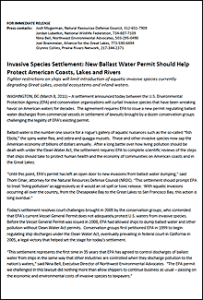Environmental Law Clinic Achieves New EPA Ballast Water Settlement
The Environmental Law Clinic of the Mills Legal Clinic at Stanford Law School is co-counsel with Pacific Environmental Advocacy Center (PEAC) at Lewis and Clark Law School, representing the Center for Biological Diversity, Northwest Environmental Advocates, and People for Puget Sound and helped achieve this settlement between their clients and the U.S. Environmental Protection Agency. The clinic is directed by Deborah A. Sivas, Luke W. Cole Professor of Environmental Law.

WASHINGTON, DC (March 8, 2011) – A settlement announced today between the U.S. Environmental Protection Agency (EPA) and conservation organizations will curtail invasive species that have been wreaking havoc on American waters for decades. The agreement requires EPA to issue a new permit regulating ballast water discharges from commercial vessels in settlement of lawsuits brought by a dozen conservation groups challenging the legality of EPA’s existing permit.
Ballast water is the number one source for a rogue’s gallery of aquatic nuisances such as the so‐called “fish Ebola,” the spiny water flea, and zebra and quagga mussels. These and other invasive species now sap the American economy of billions of dollars annually. After a long battle over how living pollution should be dealt with under the Clean Water Act, the settlement requires EPA to complete scientific reviews of the steps that ships should take to protect human health and the economy of communities on American coasts and in the Great Lakes.
Today’s settlement resolves court challenges brought in 2009 by the conservation groups, who contended that EPA’s current Vessel General Permit does not adequately protect U.S. waters from invasive species.
Before the Vessel General Permit was issued in 2008, EPA had allowed ships to dump ballast water and other pollution without Clean Water Act permits. Conservation groups first petitioned EPA in 1999 to begin regulating ship discharges under the Clean Water Act, eventually prevailing in federal court in California in 2005, a legal victory that helped set the stage for today’s settlement.
Some highlights of the settlement:
- The U.S. Environmental Protection Agency (EPA) has requested two scientific reports that will support a New VGP. The settlement calls for timely completion of these reports so that EPA can use them to meet the deadlines established for a New VGP in the settlement. EPA agreed to issue the New VGP well before the expiration date of the current VGP in order that shippers would have more time to meet its requirements.
- In the New VGP, EPA agreed to establish numeric limits on the discharge of ballast water, in lieu of merely qualitative descriptions of necessary controls in the current VGP. EPA also agreed to a minimum level of monitoring of discharges to assure compliance.
- Finally, EPA agreed to provide States more time to complete their process of putting any conditions on the New VGP required by state law, as allowed under section 401 of the Clean Water Act, and to improve communication between states during that process.
Copy of the settlement agreement (PDF).
